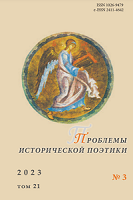Бинарные оппозиции в рождественском рассказе Л. Андреева «Ангелочек»
Binary Oppositions in Leonid Andreev’s Christmas Story “Angelochek”
Author(s): Svetlana Anatolievna Skuridina, Elena O. Kuzminykh, Marina V. NovikovaSubject(s): Christian Theology and Religion, Russian Literature, Theory of Literature, Sociology of Literature
Published by: Петрозаводский государственный университет
Keywords: Leonid Andreev; Angelochek; The Little Angel; Christmas story binary oppositions; zoomorphism; onomasticon; chronotope;
Summary/Abstract: The article analyzes the story “Angelochek” (“The Little Angel”), which has an important place in the creative work of Leonid Andreev, and is included in the school curriculum, where its plot is considered within the framework of the established literary approach to the Christmas story. Most of the researchers note the changes that occurred to the boy after his meeting with the angel, and believe that the Christmas miracle did happen, positively affecting Sashka’s life. The authors of this work propose a different approach to the story: binary oppositions (living-inanimate, truth-lie, real-fake, friendalien, man-beast, earth-sky, etc.) are revealed, reflecting the ambivalence of the writer’s view of the problem; onomastic units, which, being part of symbolic and autobiographical contexts, make it possible to clarify the intent of the work, are considered. The plot of the story is autobiographical (the angel, once removed by the future writer from the Christmas tree and placed on the stove, melts), but the main character is now a boy from a poor family who goes to celebrate the holiday to the rich patrons, the Svechnikovs. The space of the Svechnikov house is ambivalent: for the father it is a symbol of lost paradise, and for the son it is the habitat of devils, because the Christmas symbols filling the house are fake. Acquisition of humanity through the rebirth of the soul is the most significant theme of the story, realized through the “man-beast” opposition. Sashka’s family is inscribed in the zoomorphic code of the text of the story. Possessing the angel creates a feeling of “human happiness,” which results in the elimination of the animal element in the boy’s image. However, the memory of his father, who is part of the anti-house, brings Sashka’s animal appearance back. The “living-inanimate” opposition sets the parameters of Sashka’s fate, for whom “non-life” is the only possible way out of the cycle of meaningless existence. The hope for the rebirth of the boy’s soul is illusory (the opposition is “real-fake”). By the end of the story, the motifs of gravity and immersion in the abyss are intensified: the personification of salvation - a melted angel with dragonfly wings - falls to the floor at the end of Christmas. A cockroach that is unable to fly now becomes the symbol of substitution. The illusory nature of hopes is confirmed by the chronotope of the story. Christmas breaks the cycle of existence and introduces the boy to the circle of eternity, but the striking of the clock brings the heroes back to earth and accelerates their biological time. The image of the “frozen water carrier” in the story’s finale is a symbol of the return of cyclicity to the child’s life and a sign that the revival did not take place.
Journal: Проблемы исторической поэтики
- Issue Year: 21/2023
- Issue No: 3
- Page Range: 124-144
- Page Count: 21
- Language: Russian

